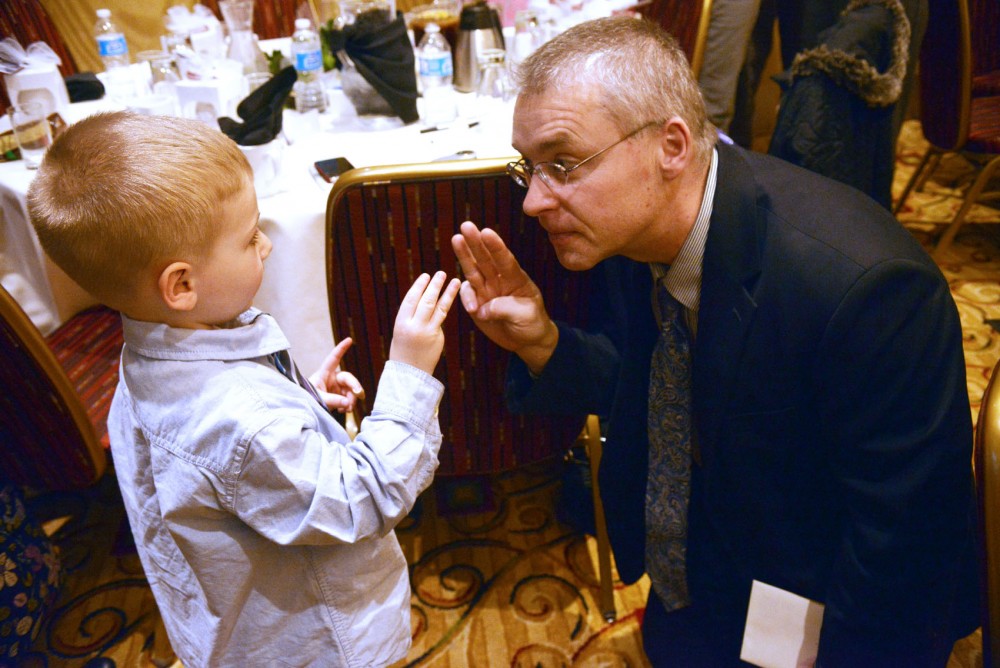Like most 6-year-olds, Charlie Knuth loves to swim and run through sprinklers.
But this wasn’t always the case.
Because of a rare genetic skin disease — Epidermolysis bullosa — blisters covered 90 percent of his body for the first four years of his life. Bathing was once a daily struggle involving infection-preventing bleach, restraints and Charlie’s screams of agony.
Today, blisters have been reduced to about 5 percent of Charlie’s body after treatment at the University of Minnesota’s Amplatz Children’s Hospital.
“The water that once tortured him is now a pure delight,” said Trisha Knuth, Charlie’s mother.
The hospital is home to the only program in the world that effectively researches and treats children with EB through bone marrow transplants, said Jakub Tolar, a pediatric blood and marrow transplant physician at the hospital.
EB causes the skin to be so fragile that even slight friction can cause severe blistering inside and outside of the body.
Without the treatment, the outlook for children who suffer from severe forms of the disease is grim: If they don’t die from the disease in infancy, they often develop a deadly cancer in their teenage years, Tolar said.
“This is an incredible constellation of suffering that is almost unimaginable for someone who doesn’t know anything about it or know anybody with it,” Tolar said.
For seven years, Tolar has been working with research and clinical teams to find a cure for EB. He has treated more than 20 children with severe forms of the disease.
Amplatz physicians treat EB using bone marrow taken from a donor’s hip or blood cells from the umbilical cord of a healthy newborn child. The donor cells make the proteins that anchor the skin to the body.
“It’s a very harsh treatment for a very harsh disease,” said Tolar, adding that several children have died during the process. Because of this risk, the program only accepts children with severe forms of EB.
He said most of the children who survive the treatment go through a “night-and-day change,” and can walk, go to school, swim and do many activities they couldn’t before with reduced blistering and stronger skin.
“It’s a privilege to be someone who can help [families] going through a very difficult route,” Tolar said. “There’s nothing that compares to it.”
Tolar said doctors learn from every new patient and are working to develop a safer treatment that could be used to treat less severe forms of EB or severe chemical and thermal burns.
“I see the evidence of his [Tolar’s] research every day because I look at my child and I can visually see how it’s changed him,” Knuth said.
Wings of Hope
Charlie was abandoned at birth. At that time, doctors predicted he would only live for about a year.
Knuth took him in two weeks later. She said he was wrapped from head to toe, and his entire body was covered in blisters. His skin was so fragile that shaking his hand could rip his skin off like a glove.
“I’m glad I didn’t know [how bad it would be],” Knuth, who later adopted Charlie, said. “I don’t know if I ever would have been strong enough to take on this unbelievable challenge.”
Over the baby monitor, she said she would hear Charlie gargling on his own blood with every breath. He had almost no skin on his tongue and would choke on skin that would fall off the roof of his mouth.
She said the blisters coating his esophagus would rupture and leave raw, open wounds.
“I never could have possibly imagined the torture and abuse that EB would inflict on my child,” Knuth said in a speech at a Wings of Hope fundraiser for the disease Saturday.
Ohio residents Mandy and Marc Seymour were at that event. They lost their 8-month-old daughter Quinn to EB on April 7.
The Seymours and their son Camden, 3, spent six of Quinn’s eight months of life at the children’s hospital, so Mandy Seymour described the trip to Minneapolis as “coming home.”
The proceeds from the benefit went to Pioneering Unique Cures for Kids, an organization dedicated to funding research to find cures for childhood diseases.
“It’s healing to come here [to the fundraiser] and be a part of something that’s bigger than us,” Seymour said.
The proceeds from the fundraising event, along with all donations collected until Dec. 31, will be matched dollar-for-dollar by two organizations represented by fathers of children with EB.
“The philanthropy has been driving the whole research basis for us,” Tolar said.
Together, the two foundations will match donations to EB research up to $450,000. According to the Minnesota Medical Foundation’s website, the fundraiser is currently about $30,000 short of its goal.
“That research is hope for families,” Seymour said. “It gave us hope for life in a time that there wasn’t any.”
Eleafar Xelhua-Romero, 11, has a form of EB that usually limits life expectancy for patients to a year.
He had a bone marrow transplant at Amplatz on Aug. 14 and said he can feel himself improving.
“It feels good because it gives me even more strength to be confident that I will pass this test that God gave me,” Eleafar said.
“I promised [my family] that I would get cured, that I would never give up, that we need to keep moving forward, to keep fighting.”








